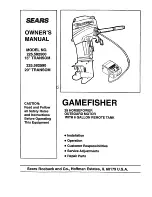AN332
Confidential Rev. 0.2
5
4. Commands and Responses
Commands control actions, such as power up, power down, or tune to a frequency, and are one byte in size.
Arguments are specific to a given command and are used to modify the command. For example, after the
TX_TUNE_FREQ command, arguments are required to set the tune frequency. Arguments are one byte in size,
and each command may require up to seven arguments. Responses provide the system controller status
information and are returned after a command and its associated arguments are issued. All commands return a
one byte status indicating interrupt state and clear-to-send the next command. Commands may return up to 15
additional response bytes. A complete list of commands is available in “5. Commands and Properties”.
Table 2 shows an example of tuning to a frequency using the TX_TUNE_FREQ command. This command requires
that a command and three arguments be sent and returns one status byte. The table is broken into three columns.
The first column lists the action taking place: command (CMD), argument (ARG), status (STATUS), or response
(RESP). The second column lists the data byte or bytes in hexadecimal that are being sent or received. An arrow
preceding the data indicates data being sent from the device to the system controller. The third column describes
the action.
Properties are special command arguments used to modify the default device operation and are generally
configured immediately after power-up. Examples of properties are TX _PREEMPHASIS and REFCLK_FREQ. A
complete list of properties is available in “5. Commands and Properties”.
Table 3 shows an example of setting the REFCLK frequency using the REFCLK_FREQ property by sending the
SET_PROPERTY command and five argument bytes. ARG1 of the SET_PROPERTY command is always 0x00.
ARG2 and ARG3 are used to select the property number, PROP (0x0201 in this example), and ARG4 and ARG5
are used to set the property value, PROPD (0x8000 or 32768 Hz in the example).
The implementation of the command and response procedures in the system controller differs for each of the three
bus modes. Section "6. Control Interface" on page 168 details the required bit transactions on the control bus for
each of the bus modes.
Table 2. Using the TX_TUNE_FREQ Command
Action
Data
Description
CMD
0x30
TX_TUNE_FREQ
ARG1
0x00
ARG2
0x27
Set Station to 101.1 MHz
ARG3
0x7E
(0x277E = 10110 with 10 kHz step size)
STATUS
→
0x80
Reply Status. Clear-to-send high.
Table 3. Using the SET_PROPERTY Command
Action
Data
Description
CMD
0x12
SET_PROPERTY
ARG1
0x00
ARG2 (PROP)
0x02
REFCLK_FREQ
ARG3 (PROP)
0x01
ARG4 (PROPD)
0x80
32768 Hz
ARG5 (PROPD)
0x00
STATUS
→
0x80
Reply Status. Clear-to-send high.


















